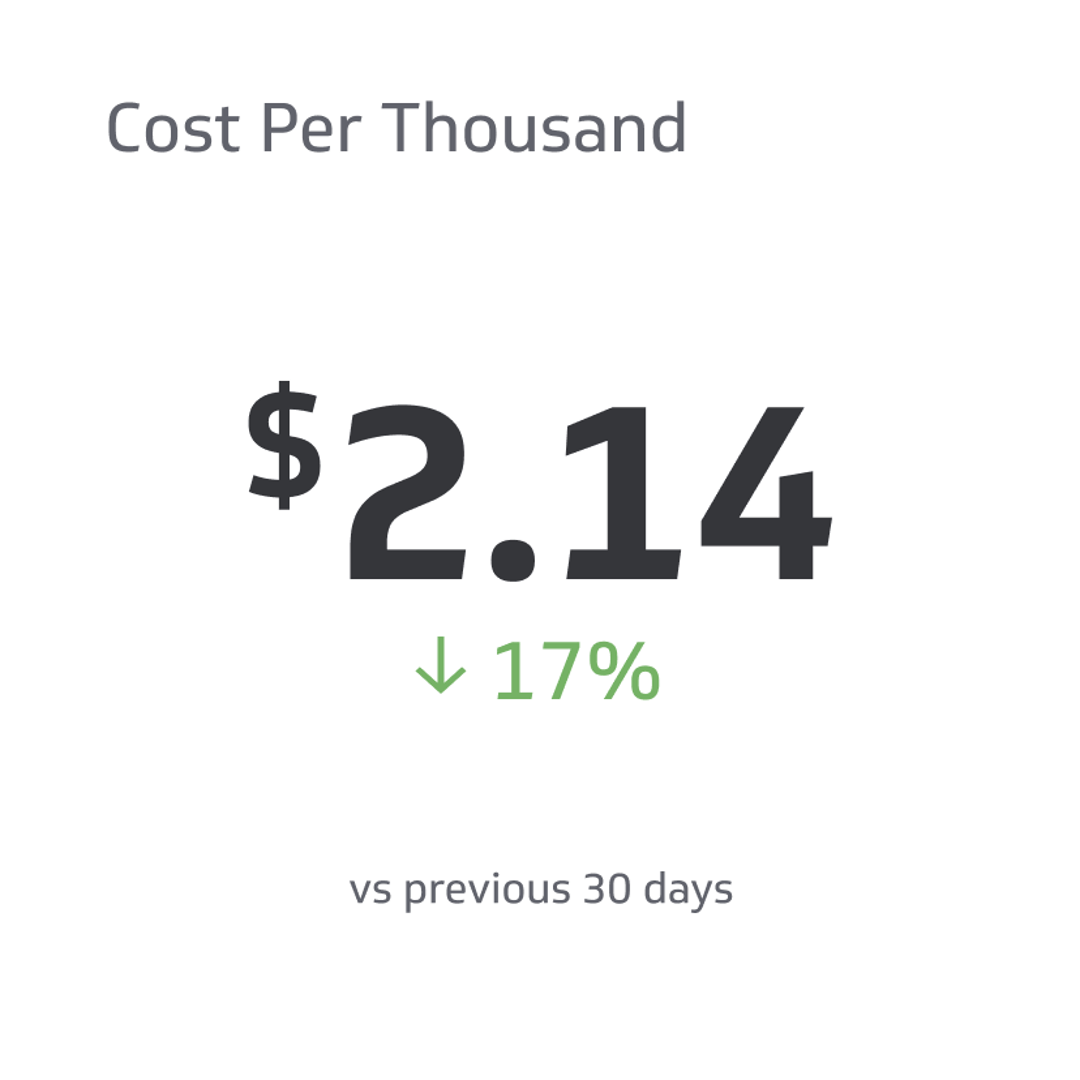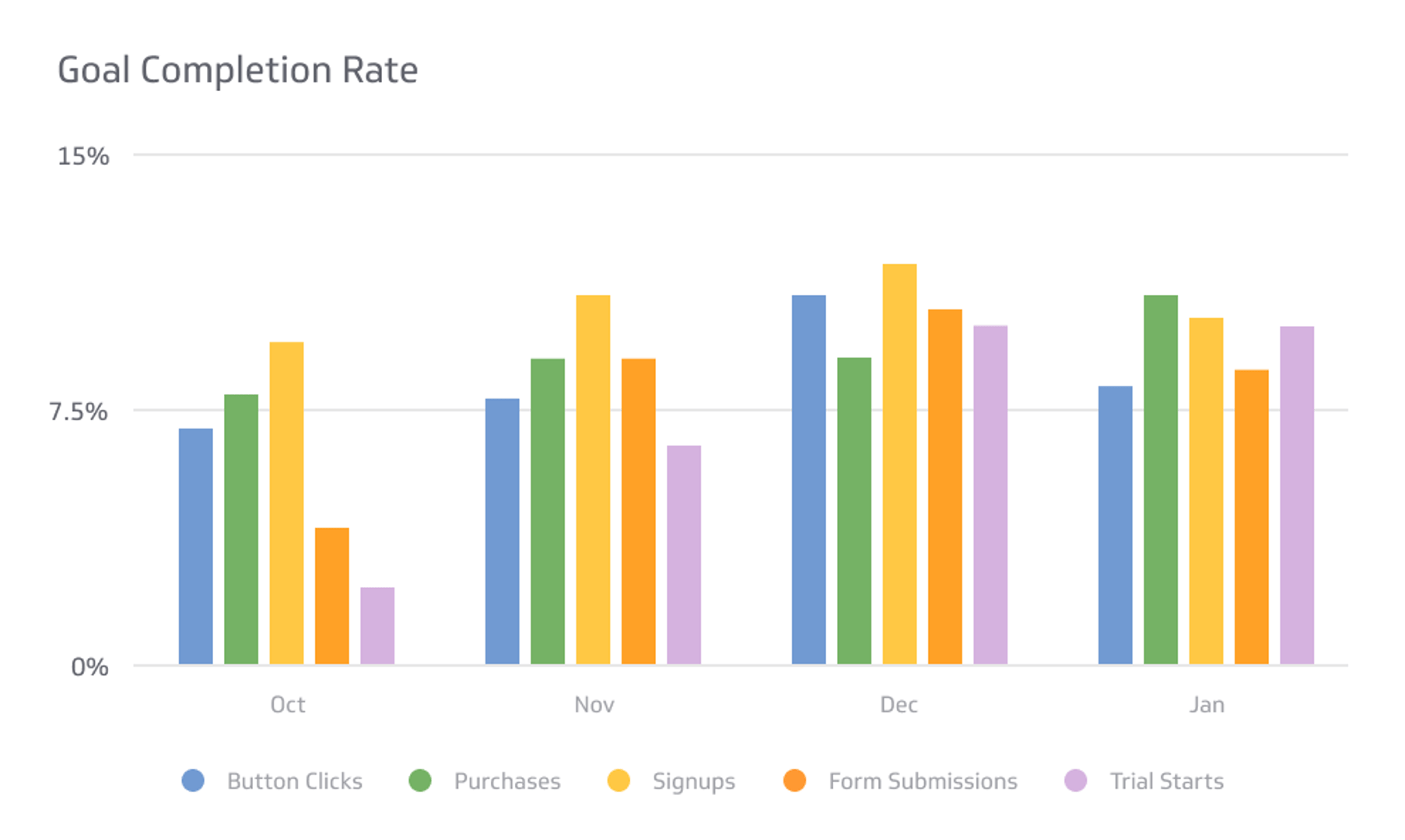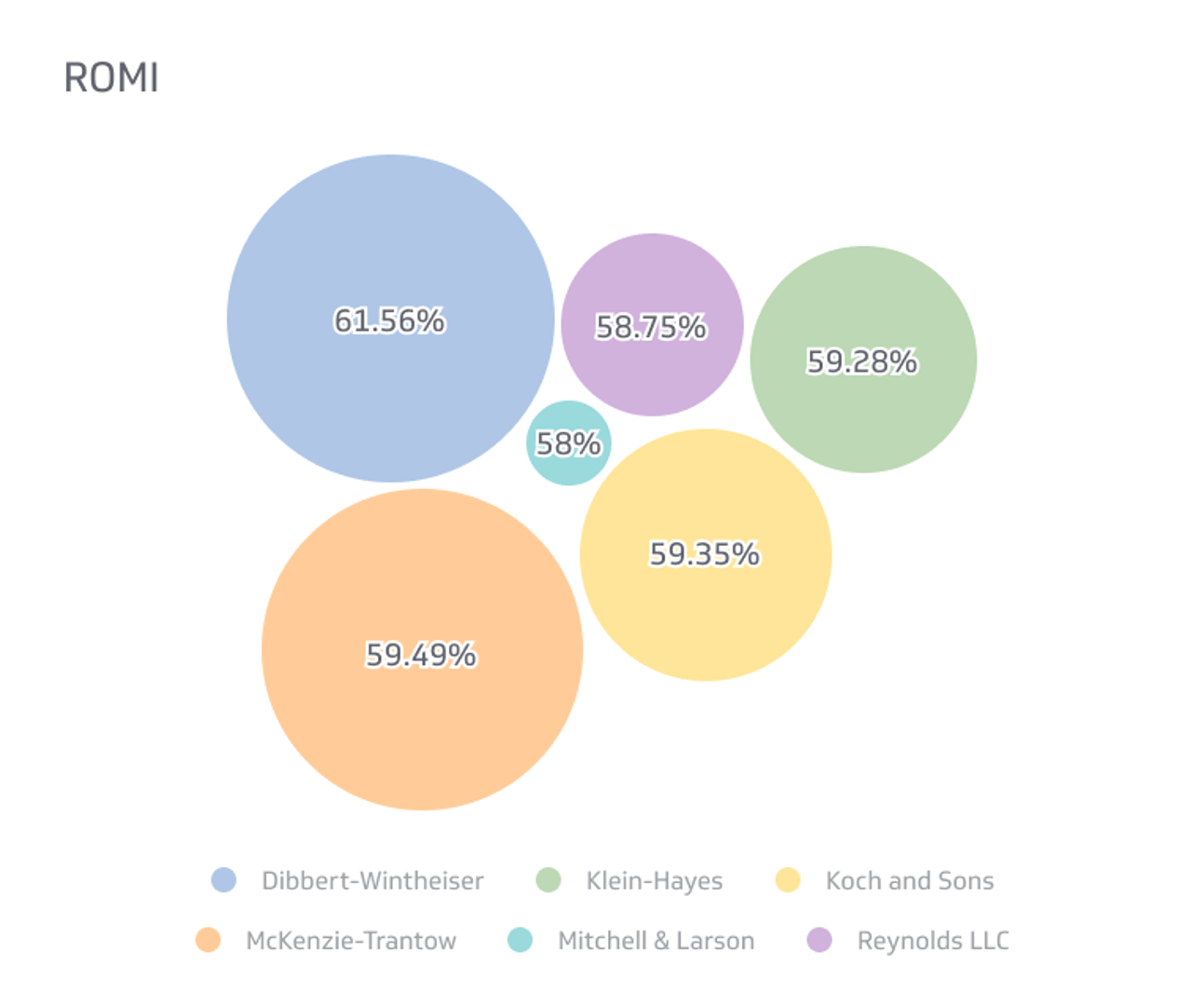Cost Per Thousand (CPM)
CPM represents the cost of reaching one thousand potential customers with a digital advertisement.
Track all your Digital Marketing KPIs in one place
Sign up for free and start making decisions for your business with confidence.

As a marketer, understanding the concept of cost per thousand (CPM) is essential to reaching your target audience in the most cost-effective way possible.
CPM measures how much it costs for your ad to be seen by 1,000 people. This metric is handy since it allows marketers to compare the cost of advertising across various platforms and create a budget that maximizes reach while minimizing expenses.
For example, if one advertising platform has a $10 CPM and another has a $5 CPM, it would make more sense to allocate more resources to the latter since reaching the same number of people would cost less. As a result, understanding CPM can help marketers optimize their ad spend and achieve their goals more efficiently.
What is Cost Per Thousand, or CPM?
Traditionally, companies relied on television, radio, and print advertisements to reach their target audience. However, with the rise of digital advertising, the landscape has shifted. CPM represents the cost of reaching one thousand potential customers with a digital advertisement.
Advertisers often use it as a benchmark for comparing the efficiency of various media channels. This metric is used extensively in the advertising industry to determine the cost-effectiveness of marketing campaigns.
When running an ad campaign, it's essential to consider the CPM carefully to ensure that the investment is efficient and profitable. A higher CPM may indicate a more targeted audience but can also result in higher costs. A lower CPM may mean a larger audience but could lead to lower engagement rates.
Therefore, businesses must balance CPM and the return on investment to achieve optimal results. CPM provides insight into the actual cost of marketing, helping businesses to allocate their resources more effectively.
This metric is beneficial for digital marketing, where online advertisements are frequently sold on a CPM basis. CPM is a standard metric used across the industry, giving marketers a comparable way to measure performance across different campaigns and channels.
By closely monitoring CPM, businesses can optimize their marketing strategies to ensure maximum results from their investments.
Benefits of CPM in Marketing
By considering CPM, companies can better control their advertising costs and reach their target audiences more effectively. With a CPM model, businesses only pay for the impressions their ads receive rather than for clicks or conversions, which can be unpredictable and costly.
Additionally, CPM allows enterprises to measure the success of their campaigns by tracking the number of impressions and assessing the overall impact of their marketing efforts. As a result, CPM has become a vital tool for businesses looking to maximize the ROI of their advertising budgets.
It continues to provide a reliable and effective way for businesses to connect with their customers.
How to Calculate CPM
Calculating CPM involves dividing the total cost of a specific marketing campaign by the number of impressions or views it generated before multiplying this figure by one thousand. This formula enables businesses to evaluate the cost-effectiveness of their advertising initiatives and make better-informed decisions regarding future investments.
By monitoring and analyzing CPM metrics over time, companies can determine which channels are most effective at driving conversions and adjust their strategy accordingly, leading to improved return on investment and higher profits. Here's a breakdown of what it takes to calculate CPM.
1. Gather Your Ad Impressions
The first step in determining CPM is calculating the total number of ad impressions your advertisement receives. This can be determined by multiplying the number of views for each page on which the ad appears by the frequency at which it occurs (e.g., once per page view, twice per page view, etc.).
2. Divide Ad Cost by Impressions
After calculating your total impressions, divide them into the cost you paid for ads during a given period of time. For example, if you purchased $500 worth of ads over a month and received 10 million impressions from those campaigns, your cost per impression would be $0.05 ($500 divided by 10 million).
3. Multiply Your Result By 1,000
Once you have calculated your ad’s cost per impression, multiply that figure by 1,000 to accurately represent cost per thousand or CPM ($0.05 x 1000 = $50 CPM).
How to Optimize Your CPM Campaigns
Optimizing your CPM campaigns is crucial to achieving the best results in today's highly competitive digital advertising landscape. By analyzing your data and making necessary adjustments, you can ensure that your campaigns reach your target audience and deliver the desired outcomes.
Tips for optimizing your CPM campaigns include using high-quality and creative ad copy, testing different audience targeting strategies, experimenting with ad formats, and monitoring your campaigns regularly to make data-driven decisions.
By investing time and resources into optimizing your CPM campaigns, you can maximize your return on investment and garner success for your business.
Use High-Quality Copy
An essential factor in creating an effective ad campaign is prioritizing your ad copy's quality and creativity. After all, the text within your ads serves as your brand's voice, conveying your message to your target audience.
Subpar ad copy will fall flat, failing to capture attention, convey your brand’s messaging, or convert potential customers. Using high-quality and creative ad copy can help ensure success, enabling your campaign to stand out amidst the endless stream of advertisements that flood consumers’ screens daily.
Investing in exceptional ad copy can improve your ads’ relevance score, lower your costs, and ultimately maximize the effectiveness of your advertising campaigns.
Experiment With Audience Targeting
Targeting the right audience is probably the single, most important step for maximizing an ad campaign's effectiveness. However, it is not a one-size-fits-all approach.
Experimenting with different ways to target an audience is vital for identifying what works best for your campaign. This could include trying other social media platforms, refining your messaging, or utilizing influencers.
By testing different strategies, you can gain valuable insights into what resonates with your audience and adjust your approach accordingly. This process improves your campaign's effectiveness and helps you better understand and connect with your target audience for future initiatives.
In today's competitive marketplace, continuously experimenting and adapting is essential for staying ahead of the curve.
Try Out Different Ad Formats
In the modern age, technology moves fast, as do people's attention spans. It's crucial to try out different ad formats to maximize the effectiveness of ad campaigns. By diversifying your ad formats, you can reach a wider audience and increase engagement with your advertisements.
Different ad formats resonate with varying demographics, so experimenting allows you to tailor your messaging and visuals to specific groups of people. Whether it's image, video, or interactive ads, trying out different formats ensures that your ad budget is used effectively and efficiently.
Don't be afraid to test new designs. It could lead to greater success and a more substantial return on investment for your campaigns.
Keep An Eye on Metrics
Analyzing data and making adjustments are critical for the success of any ad campaign. With the vast amount of data available, it's essential to have the right analytical tools and strategies to gain insights and convert them into actionable steps.
Data-driven analysis can help identify patterns in consumer behavior, demographics, geographical location, and even purchasing history. By adjusting the ad campaign content, timing, and targeting based on these insights, one can significantly increase the campaign's effectiveness.
With proper analysis and adjustments, ad campaigns can reach the right audience, resonate with them, and bring in the desired results in the form of conversions, leads, and revenue. In today's fast-paced digital world, ad campaigns that don't emphasize data analysis and adjustments risk falling behind the competition.
Key Takeaways for Maximizing Advertising Success
Here's the rundown of what it takes to craft a compelling and engaging ad campaign:
- Monitor and analyze your CPM metrics to identify the most effective channels in driving conversions.
- Utilize targeted campaigns to reach specific audiences.
- Invest in creative ad designs that are more likely to engage viewers and generate clicks.
- Test different ad placements on websites or platforms to see which ones generate higher returns on investment.
- Research competitors’ advertising efforts for insight into their strategies and tactics.
- Take advantage of new technologies, such as remarketing, retargeting, and programmatic buying, to improve click-through rates.
- Keep track of customer feedback so that you can adjust campaigns accordingly.
- Utilize analytics tools like Google Analytics or Adobe Analytics for detailed insights into campaign performance.
Challenges Associated With Running a CPM Campaign
Running a CPM campaign can be challenging, just like any other marketing venture. One of the critical challenges is reaching your target audience. With CPM campaigns, you pay for every impression of your ad, meaning that if your ad is not being shown to the right people, you're wasting your advertising spend.
One effective strategy to overcome this challenge is to research and understand your target audience in detail. Use tools like Google Analytics to obtain valuable insights into your audience's demographics, interests, and online behaviors.
Additionally, ensure your ad is creative, visually appealing, and effectively delivers your message. This helps grab the attention of your target audience and encourages them to interact with your ad, driving more impressions and, ultimately, a higher click-through rate.
Taking the time to understand your audience and crafting compelling ads can help you overcome the common challenges of running a CPM campaign.
Future Trends in the Use of Cost Per Thousand in Marketing
As the marketing industry continues to evolve, it can be expected that the use of the CPM pricing model will become more prevalent. With the rise of programmatic advertising and the increasing amount of data available, CPM has become a more sophisticated tool for predicting campaign performance, allowing marketers to make more informed decisions.
Up-and-coming technological advancements, such as virtual and augmented reality, will require new pricing models that reflect their unique engagement characteristics. As a result, we can expect to see the use of CPM in niche channels grow in the future, along with the development of more accurate and efficient measurement techniques.
As marketers look for ways to optimize their campaigns, CPM will remain a valuable digital marketing metric in measuring advertising effectiveness.
Final Words on Cost Per Thousand
In marketing, knowing how to allocate your budget effectively can mean the difference between failure and success. That’s where the cost per thousand comes in. CPM determines the cost of reaching one thousand people with an advertisement. Understanding how to calculate CPM and use it to your advantage is crucial for any marketer.
By utilizing CPM, businesses can accurately assess the cost-effectiveness of their marketing campaigns and make informed decisions about future investments. It’s a powerful tool to help companies to grow their reach and increase their overall return on investment.
So, whether you’re just starting or looking to improve your marketing strategy, understanding the basics of CPM is essential.
Related Metrics & KPIs



.png)